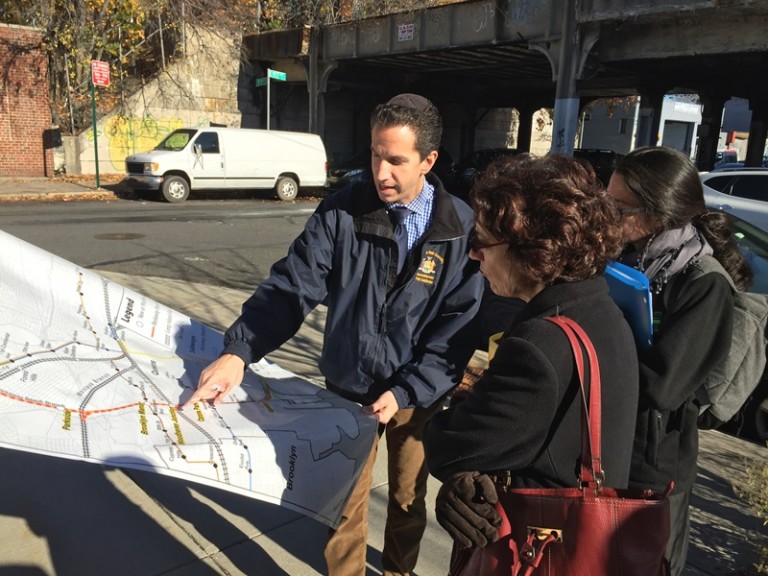PHOTO: Assemblyman Phil Goldfeder last Friday hosted city Transportation Commissioner Polly Trottenberg (foreground) and DOT Queens Borough Commissioner Nicole Garcia on a tour of the portion of the defunct Rockaway Beach Rail Line that runs through Ozone Park. Photo Courtesy of NYS Assembly
Assemblyman Phil Goldfeder (D-Howard Beach) last week welcomed city Transportation officials to the 23rd District and led them on a tour of part of the abandoned Rockaway Beach Rail Line.
Transportation Commissioner Polly Trottenberg and DOT Queens Borough Commissioner Nicole Garcia last Friday joined Goldfeder on a tour of the Ozone Park portion of the defunct RBRL. Starting at the corner of 99th Street and 97th Avenue, the officials trekked along 99th Street to discuss reactivating the line that ceased operating in 1962.
“It was an honor to lead DOT Commissioner Trottenberg on a tour of the Rockaway Beach Rail Line and discuss various options for restoration of the old line,” Goldfeder said. “Commissioner Trottenberg and her team have been tremendous advocates for improving transportation here in Queens and I appreciate her coming to see the rail line firsthand and considering what its reactivation could mean for our transit-starved families.”
Last Friday’s tour came on the heels of Goldfeder’s testimony at a City Council Transportation Committee oversight hearing on proposals to improve access to mass transit in underserved communities in all five boroughs.
Specifically, Goldfeder pledged his support of Council Resolution 903-2015, calling on the Metropolitan Transportation Authority to conduct a feasibility study of the Rockaway Beach line and other city-owned rail rights-of-way.
“There is no greater asset to our transit network than existing rights-of-way. With the Rockaway Beach Rail Line and the other underutilized rights-of-way throughout the city, we have a once-in-a-lifetime opportunity to make lasting improvements to our transportation network and meet the demands of our growing populations,” Goldfeder testified. “I fully support the proposed Council Resolution 903-2015 calling on the MTA to study the potential use of these vital assets; and urge the City Council to continue its advocacy on behalf of our families as we work to end transportation deserts and create the equal access to transit options we deserve. As Queens residents, we are not asking for more than others, but rather for a fair share, to give our families the opportunity to thrive and grow.”
Trottenberg also testified at the Nov. 12 hearing, detailing DOT’s efforts to improve road infrastructure in the five boroughs.
Goldfeder has been rallying for reactivation for years. In 2014, he trumpeted the findings of a highly anticipated Queens College study that indicated, in part, that a revitalized RBRL could generate 500,000 subway rides per day, and that many residents in the communities through which the line runs—Rego Park, Forest Hills, Glendale, Richmond Hill, Woodhaven and Ozone Park—favor reactivation over transforming it into a park.
Reactivating the old line would cost approximately $1 billion, according to the study.
Also last year, Goldfeder coordinated a joint letter in which a majority of his Queens Assembly colleagues signed on in support of asking the MTA for a feasibility study into reactivating the line.
Beginning in the late 1800sm, the Rockaway Beach Branch of the Long Island Rail Road served commuters from the Rockaway Peninsula through Rego Park. For more than 50 years, the line provided a 35-minute ride to midtown Manhattan.
Financial woes and disrepair led to the transfer of the line to the city from the LIRR shortly before it was shuttered in 1962. The southern section of the line was later converted into the present-day A Train, while the sections north of Liberty Avenue were left untouched. To this day, the right-of-way is still in city hands and much of the original elevated train trestle remains intact, according to Goldfeder.
By Michael V. Cusenza
michael@theforumnewsgroup.com

